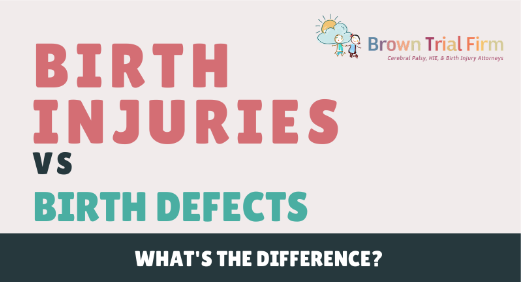The doctor who delivered my baby missed the warning signs of a baby in distress.
Now my child has permanent disabilities.
Did your newborn suffer a birth injury due to medical negligence?
Talk to an injury attorney who has dedicated her entire career to birth trauma cases.
“They went above and beyond to give our family a level of closure that was vital for us to move forward...” - Della C.
“They worked their hearts out to get justice for a young child...I have been a lawyer for 20 years, and can honestly say that this law firm could be the best medical malpractice firm in the country.” - Reynaldo Garza III
lawyer
“I will definitely recommend them to any family. Laura is definitely hands down an amazing lawyer.” - Jacklyn C.
All parents wish the best for their new baby. We hope, we pray, we change and adapt our own lifestyles to prepare for our own little miracle, and we put our trust in the medical system to do the right things to protect our newborn. Today’s medical imaging and technology is much better than it was even a few years ago.
The bad news? Preventable birth injuries still happen in as many as 30 percent of deliveries.
Birth injuries may be caused by medical negligence. Hospitals, nursing staff, doctors and other medical professionals are required to follow certain “standards of care.” These standards exist to ensure that patients receive proper medical care and to protect patients from preventable injuries. Medical professionals can be held legally accountable when they fail to follow a reasonable standard of care and this negligence causes a birth injury.
If your baby was injured and you have questions, we can help you get answers. At Brown Trial Firm, we’ve devoted our entire practice to fighting for accountability and responsibility for preventable birth injuries. Doctors and hospitals have deep pockets and expensive lawyers at their disposal. We help even the playing field for patients by exclusively representing babies and their families. We’re ready and willing to go up against even the largest hospital corporations or insurance companies. Years of devoted practice have instilled us with confidence, experience and the skills to match.
We serve families nationwide.
Have questions about a birth injury?
Verdicts & Settlements Financial security for Your Child
Birth injury cases are like babies—every one is unique and special. Although these past success stories are no guarantee of success in your case, they can provide you examples of what we’ve been able to accomplish in similar cases. Contact us to determine the value of your potential claim.
HIE Malpractice Lawsuit
The child’s HIE and CP were caused by hypoxia and ischemia when the umbilical cord wrapped around the child’s neck, preventing the child from getting enough oxygen. The medical providers did not identify the warning signs and did not order a timely c-section. The delay caused severe and permanent injuries.
Cerebral Palsy Malpractice Lawsuit
The child suffered HIE and CP injuries when the medical professionals failed to timely order and perform a c-section in response to fetal distress warnings. A contingent (%) fee charged on the successful recovery resulted in a fee of $3,080,000 and litigation expenses and attorney’s fees which were reimbursed by the client out of the gross settlement amount.
Cerebral Palsy Malpractice Lawsuit
The child suffered HIE and CP as a result of uterine rupture, placental abruption, and a delay in performing an emergency c-section. A contingent (%) fee charged on the successful recovery resulted in a fee of $1,441,584 and litigation expenses and attorney’s fees which were reimbursed by the client out of the gross settlement amount.
What are the common causes of birth injuries?
Birth injury or trauma is a natural part of the birthing process to some extent. After all, the baby is being squeezed through the mother’s pelvis, and during contractions the baby’s oxygen supply is temporarily stopped. Each phase of labor involves compression, twisting and tensing of the body. Even infants delivered by Cesarean section (or c-section) must first endure the stress of prolonged labor.
Children born with minor birth injuries typically recover on their own, without treatment. However, serious birth injuries can be life-threatening or cause long-term disabilities and impairment.
There are 2 main reasons why babies are injured during birth:
Oxygen deprivation (hypoxia)
Before, during and after delivery, babies must have a steady and reliable flow of oxygen. It can take as little as 6 minutes for a child to suffer from brain death. A baby may not receive enough oxygen if there is a uterine rupture, a placental tear, an infection or an umbilical cord that is kinked or wrapped around the baby’s neck.
When the baby is stuck inside the birth canal for too long or has a blockage of umbilical blood flow, their oxygen reserves run out. A lack of oxygen and buildup of carbon dioxide in the blood, tissues and organs is serious. Cerebral palsy, “perinatal asphyxia,” hypoxic-ischemic encephalopathy (HIE) and other types of lifelong brain damage are all caused by oxygen deprivation.
Physical trauma
Commonly, birth trauma injuries occur when a medical provider uses too much mechanical force during delivery. Cuts, bruises, bleeding, swelling, burst blood vessels, broken bones, damaged nerves and paralysis are all types of mechanical damage the baby might suffer on the way out. Usually, these injuries are considered “minor” and heal by themselves, but some types of nerve damage—like a severe brachial plexus injury—do not heal at all.
Medical providers may have difficulty delivering a baby when the baby is either too large or positioned abnormally. Medical providers may use forceps or vacuum extractors to reposition the baby or force the baby through the birth canal. The risks of injuries associated with these instruments can often be prevented by ordering and performing a c-section delivery.
Other common causes of birth injuries include:
- Delayed c-section delivery. During difficult labor or delivery, a cesarean section may reduce the risks of serious injury. Delivering the baby by c-section removes the baby from an environment where they’re not receiving sufficient oxygen. If a doctor waits too long to begin a c-section, the baby may be injured.
- Meconium aspiration syndrome. Meconium aspiration syndrome occurs when the baby breathes in a mix of feces (meconium) and amniotic fluid before or during birth. When a baby is experiencing stress during labor and delivery, the baby may involuntarily gasp. As the baby gasps, its lungs fill with meconium and amniotic fluid. Sometimes the lung is only partly blocked, and sometimes it is completely blocked. As a result, the baby’s lungs may collapse. Another risk is a lung infection, which comes as a result of inflammation of the lungs (pneumonitis).
Medical errors are a leading cause of birth injuries
Although they may be highly trained, physicians, nurses, midwives, hospital staff and EMTs are human and they can make mistakes that cause injury to newborns. Common medical errors that can lead to a birth injury or trauma include:
- Not monitoring the baby closely for signs of distress
- Improper use of forceps
- Improper use of vacuum extractor
- Excessive pulling or “traction” on the baby
- Giving medications to the mother shortly before or during delivery that put the child at risk
- Miscommunications or misunderstandings between medical staff
- Failing to perform an emergency C-section when needed
Some birth injuries simply wouldn’t exist if medical providers never made mistakes. Brachial plexus injuries, including Erb’s palsy and Klumpke’s palsy, are almost always caused by doctors or medical staff pulling or twisting the baby’s head and neck while trying to deliver it.
Birth injuryrisk factors
Even in the best of times, childbirth is a risky proposition for both the mother and the baby. When severe birth injuries occur, it’s usually a combination of risk factors and improper or slow medical intervention by the doctor.
The following factors pertaining to the baby or the mom are loosely associated with greater risk of fetal injury:
Fetal birth injury factors
- Prematurity. Babies born before 37 weeks have a higher risk of birth injuries because they are more fragile and have fewer natural defenses.
- Large baby (macrosomia). If the baby is too large to travel through the mother’s pelvis, there’s a greater risk of injury, specifically due to shoulder dystocia.
- Abnormal delivery positions. Physicians should be able to determine what position a child will be born in a week before delivery. If the baby is “breech” or in a face-first presentation, complications could be prevented with c-section delivery.
- Umbilical cord complications. Problems in the umbilical cord can cause the baby to develop too slowly inside the womb, be deprived of oxygen and nutrients and suffer fetal distress.
- Placental complications. When the placenta is compromised, both mother and baby are in danger. The placenta can detach too early, cutting off the baby’s blood and oxygen supply—or it can cause excessive bleeding and infection in the mother.
- Shoulder dystocia. This is possibly the most dangerous situation in labor. When the baby’s head comes out of the birth canal but his or her shoulders are stuck on mom’s pelvis, it’s a type of “dystocia” or difficult birth that needs to be resolved quickly. Since the baby is already partly out, a c-section can’t be performed. Dystocia is sometimes associated with the mother’s birthing position.
Maternal birth injury factors
- Delayed birth/prolonged labor. Delayed birth is a leading cause of birth injuries. Pressure on the child’s brain may become too much to withstand when the baby remains in the birth canal for more than 18 hours. Many medical professionals believe that labor lasting more than 18 hours requires an emergency c-section.
- Cephalopelvic disproportion. If the mother’s pelvis is not shaped to accommodate vaginal birth, or if the child is too large, it can lead to abnormally long labor or shoulder dystocia. Compression can cause injury to the baby’s brain.
- Obesity. If the mother is overweight, she is at higher risk for gestational diabetes and preeclampsia, which can cause fetal distress. Around 36 percent of Americans are considered medically obese (having a BMI of 30 or greater).
- Infections. Some viral or bacterial infections can be transmitted from mother to baby while the baby is still in utero. Others can be transmitted during the birthing process if proper precautions are not taken by medical professionals. Infections can include cytomegalovirus, toxoplasmosis, parvovirus, syphilis, listeriosis, hepatitis, HIV or Group B streptococcus. Testing needs to be done during pregnancy. Many of these conditions can be treated with antibiotics, vaccines or c-section delivery to reduce the baby’s exposure.
- Uterine problems. Weak contractions, strong contractions or a previous c-section scar causing uterine rupture can harm the baby. Giving labor-inducing medication to the mother can increase the risk of uterine problems.
When a serious birth injury occurs, the clock starts running. The sooner you act, the more options are available for the treatment of your child’s birth injury. Early intervention is proven to improve the quality of life of many children who have suffered a birth injury.
What to do if your child has a birth injury
If your child has a birth injury that you think could have been prevented or avoided with proper medical care, it’s important to act quickly. The sooner you get help, the sooner your child can get access to vital treatment, care and therapy. Intervening early with the right care can help minimize some of the long-term struggles your child may face.
Chronic medical issues caused by a birth injury can include:
- Permanent disabilities to the brain and to the body.
- Delayed development, difficulty in school and an inability to achieve independence in adulthood.
- Significant medical costs, including hospitalizations, multiple surgeries, skilled nursing care, physical therapy, occupational therapy, customized equipment and round-the-clock caretaking.
After you’ve sought treatment from a different medical provider for your child’s birth injury, take the next step by consulting with an experienced birth injury attorney near you. The costs associated with a birth injury can be extremely high, and we can help you secure the funds you need to give your child the best future possible.
What are common birth injuries?
Actions have consequences. When medical providers deviate from the standard of care, they put their patients at risk of injury. Many types of birth injuries are caused by medical providers who aren’t watching for the warning signs of a birth injury. By following the standard of care and acting in a timely manner, many birth injuries can be prevented.
Medical malpractice cases typically start with an investigation into what happened to cause the birth injury and why. Common types of birth injuries caused by medical negligence include:
- Meconium aspiration
- Brain injuries (e.g. HIE, and cerebral palsy)
- Brachial plexus injuries (e.g. Erb’s Palsy, where the child’s arm is weak or paralyzed)
- Nerve damage (e.g. Klumpke’s Palsy, where the hand takes on a claw-like shape)
- Infections (e.g. anemia, folic acid deficiency or spina bifida)
- Lethargy
- Spasticity
- Bleeding from the forceps, the scalp or the skull
- Hypoxia (lack of oxygen)
- Seizures
- Cranial nerve trauma
- Spinal cord damage
- Facial paralysis
- Death
What Are the Steps for Filing a Birth Injury Lawsuit?
- Consultation. If your baby suffered a birth injury, your first step should be to learn about your legal options by consulting with an experienced birth injury attorney in your area to review the specific circumstances surrounding your case. Each case is different, so it’s important that a knowledgeable attorney looks at the facts of your unique case to determine if medical malpractice and negligence was the culprit. At Brown Trial Firm, your first consultation is free.
- Filing. Once our birth injury attorneys have determined that a lawsuit is warranted and you hire us, the next step is to file a claim with the appropriate court system and serve the defendant a notice of your lawsuit.
- Discovery. Before your case goes to trial, there are several pre-trial steps to undergo—starting with “discovery.” Discovery is when the plaintiffs and defendants exchange information about their respective arguments in order to allow all parties to understand what evidence the other side intends to use.
- Depositions. Depositions are another pre-trial step that involves getting sworn testimony from witnesses. This testimony can be used to shed light on your case—for example, by revealing what medical providers actually knew about the conditions that caused the birth injury before, during or post-birth.
- Investigation. From the moment we accept your case and file a lawsuit, our attorneys will conduct a thorough investigation into your baby’s birth injury by consulting with medical experts to determine if the standard of care was breached and who is responsible for your baby’s injury.
- Mediation. Mediation is the last pre-trial step, and it’s where most birth injury cases are settled. During mediation, our attorneys will push for a full and fair resolution of your case out of court, while also ensuring that the other party is negotiating in good faith.
- Trial. If the other party is unwilling to settle or negotiate in good faith, we are ready to represent you and your family in court before a judge and jury. Our skilled litigators will back up your case with strong evidence and testimony from expert witnesses. While going to trial is always a risk, we will give your case the best possible odds of succeeding.
Nobody looks forward to filing a lawsuit. On top of the monumental challenge of taking care of a newborn with special needs, pursing legal recourse against a doctor or hospital may seem overwhelming and impossible.
But that’s where we can help.
Our birth injury attorneys can help you make an informed decision about what steps to take next and if filing a lawsuit is truly in your family’s best interests. Contact the Brown Trial Firm today to schedule your free consultation and take the first step.
Birth injuries vs
birth defects
What’s the difference between a birth injury and a birth defect?
We get this question regularly. It’s important to understand the distinction between the 2 terms as they are vastly different.
Simply put, birth defects are health conditions that form while the infant is still in the womb and are typically due to genetics. Birth defects are often unavoidable and include conditions such as Down syndrome, clubfoot, cleft lip and palate, and heart murmurs.
Birth injuries, on the other hand, are health problems that typically develop at or near the time of birth and are not caused by genetics. These injuries are usually preventable and due to medical errors or negligence. Common birth injuries include cerebral palsy and HIE.
How to tell if your baby suffered a birth injury
First, there must be an evaluation of the medical records and information about the events that occurred during labor and delivery. The condition of the mom and the baby are important details. We also frequently get questions from parents about the APGAR scoring system and how an APGAR score relates to a birth injury.
An APGAR score is a tool commonly used to evaluate the health of a newborn. If you aren’t sure if your child has suffered a preventable birth injury, the best thing to do is to contact an experienced birth injury attorney for a consultation. Our knowledgeable attorneys can help investigate your case to find out what happened and whether the injury was preventable.
Contact an experienced birth injury attorney
Medical professionals are trained to do everything possible to keep a mother and child safe during labor and delivery. When they fail in their duty and cause birth injuries to your child, you have every right to take legal action.
If your child suffered a serious birth injury, you must act immediately. At Brown Trial Firm, our birth injury attorneys can help you find answers to your questions. We can advise you about your child’s legal rights, and whether you have a legal claim for compensation. You may be entitled to compensation for medical bills, hospital visits, and future care like therapy and medical caretaking.
The sooner you act, the better the result can be for your child. We will fight for you and for your family to ensure that you are fairly compensated for preventable losses. If you suspect your child’s birth injury was caused by a preventable medical mistake, please contact our birth injury attorneys. Consultations are completely free and there is no obligation.
- Cerebral Palsy
- Caput Succedaneum and Cephalohematoma
- Neonatal Intracranial Hemorrhage (Childbirth Brain Bleeds)
- Hydrocephalus (Extra Fluid in the Brain Cavity)
- Cervical Dystonia
- Hemiplegia (Brain or Spinal Cord Injury)
- Hemorrhagic Stroke
- Neonatal Stroke
- HIE
- Periventricular Leukomalacia (PVL) Brain Injury
- Infant Seizures
- Spastic Diplegia (Spasticity in the Legs)
- Top Risks for Birth Injuries
- Fetal Alcohol Syndrome
- Facial Paralysis
- Spinal Cord Injuries
- Bell’s Palsy
- Brachial Plexus Nerves & Erb’s Palsy
- Klumpke’s Palsy
- G-Tubes for Newborns
- Medical Errors
- Cesarean Section & Birth Injury
- Negligence in Brain Cooling Treatment
- Craniosacral Therapy
- Occupational Therapy
- Speech Therapy
- Transition From Pediatric to Adult Healthcare
- Surgical Options for Spastic Cerebral Palsy
- Fetal Intolerance to Labor
- Jaundice (Kernicterus)
- Breech Position
- Placental Complications
- Umbilical Cord Problems
- Uterine Rupture
- Cervical Incompetence (Insufficiency)
- Blighted Ovum
- Necrotizing Enterocolitis (NEC) - Intestinal Inflammation
- Cephalopelvic Disproportion
- Meconium Aspiration Syndrome
- Amniotic Fluid Embolism
- Birth Injury from Premature Delivery
- Developmental Delays
- Abnormal Cord Insertion
- Infections at Birth
- Chorioamnionitis Bacterial Infection
- Premature birth
- Oxygen Deprivation
- Listeria
- Birth-Acquired Herpes
- Placenta Previa
- Placental Abruption
- Mismanaged Fetal Malposition
- Rapid Labor
- Obesity Related Birth Injuries
- Intrauterine Growth Restriction
- Blood Clots During Pregnancy
- Ectopic Pregnancy Misdiagnosis
- Myths & Facts About Birth Injuries
- Bacterial Vaginosis
- Gestational Diabetes
- Maternal Mortality Risk
- Oligohydramnios (Low Amniotic Fluid)
- Infections During Pregnancy
- Excessive Bleeding During Pregnancy
- Congenital Syphilis

 See our infographic
See our infographic

